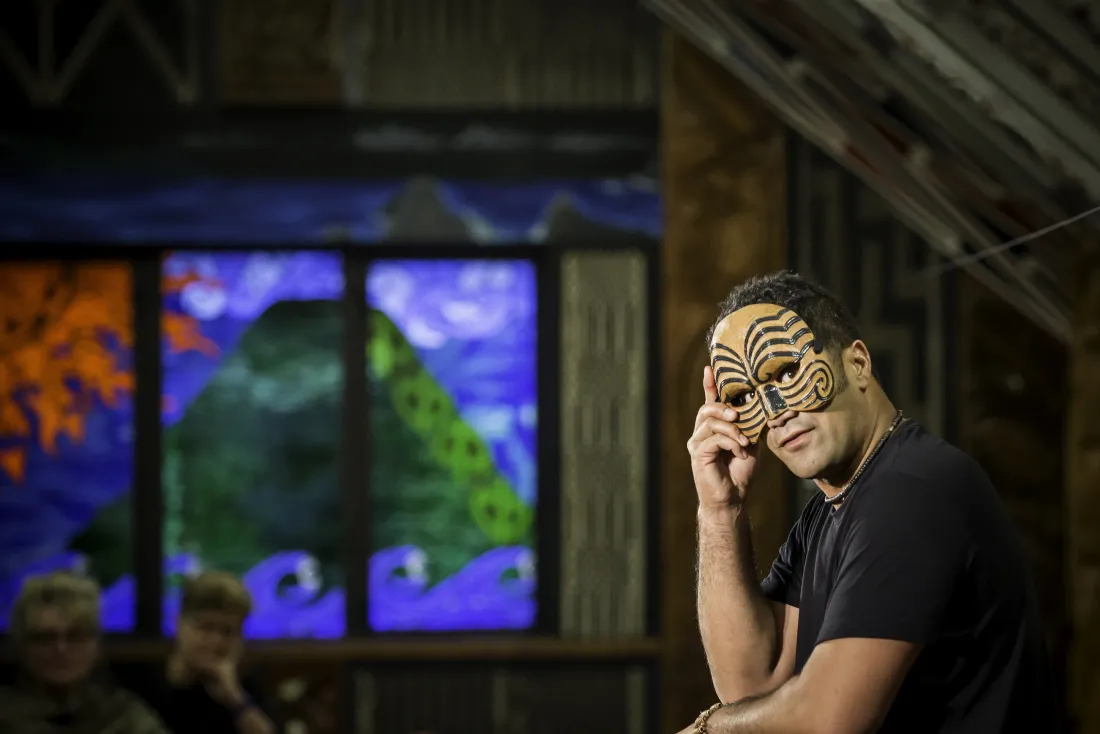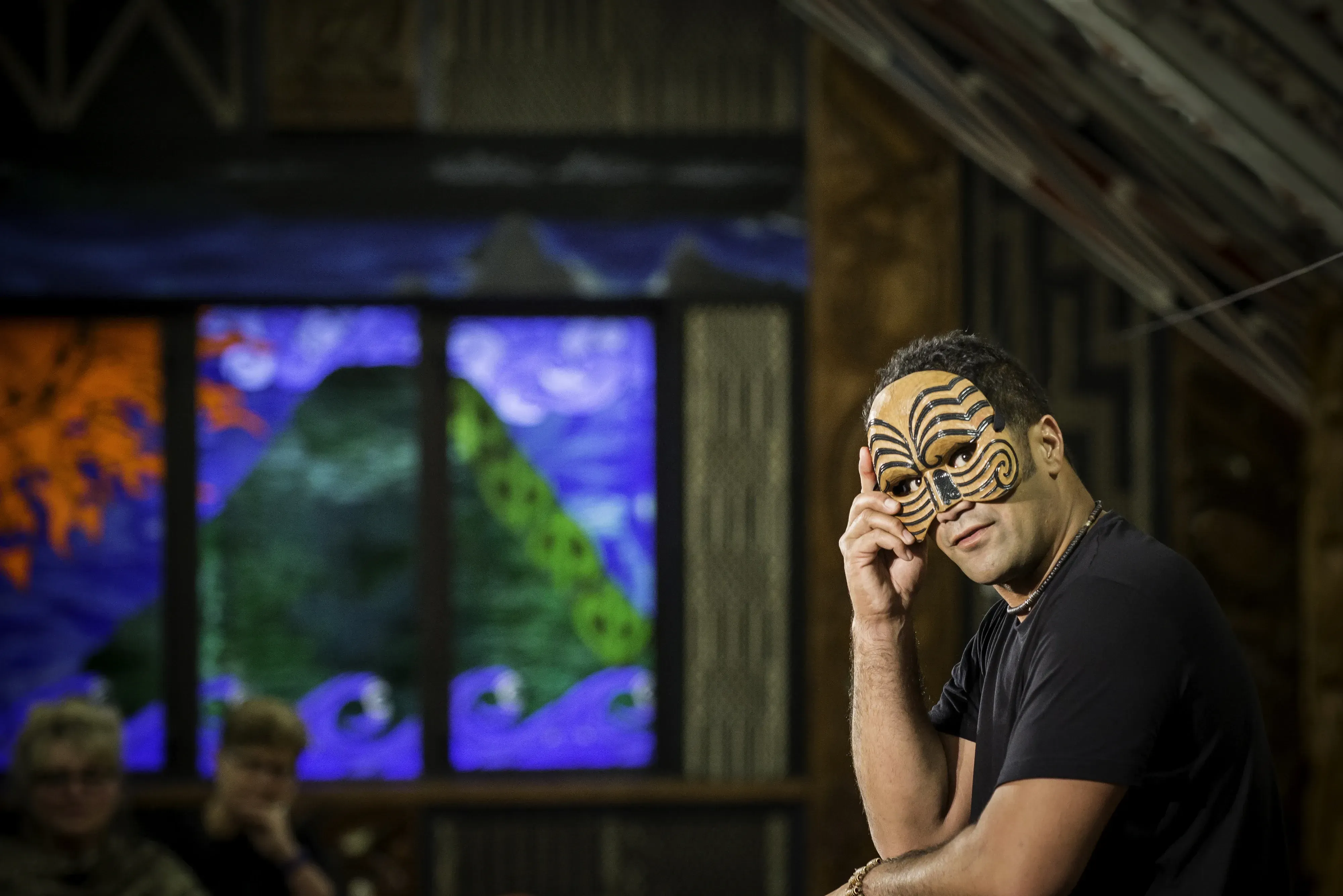Masking the Bard


SolOthello, a solo performance and adaptation of Shakespeare’s Othello by Regan Taylor, will be touring to Wellington and Auckland during Matariki, then Nelson and Hawke's Bay this year.
Developed by Taylor (Ngati Kahungunu) and director Craig Geenty to showcase the new form of Te Mata Kokako o Rēhia (Māori Performance Mask), SolOthello weaves together the original prose, modern English and Te Reo Māori to deliver a dynamic and cheeky interpretation of one of history’s more tragic plays. Renee Liang caught up with Regan Taylor.
When did you first come up with the idea of Maori masks?
In the summer of 2001 when I was a second year student at the UCOL Theatre School. We had a guest tutor in teaching a block course on Commedia Masks. I put on the Arlecchino mask and started talking gibberish Māori – I wasn't fluent at all but with my limited Reo and the mask everything came together beautifully.
It was then that I realised that different nations have their own relationship with the masked world i.e. Balinese, Japanese Commedia to name a few.
After thinking about this, I then went to local marae and looked at the carvings in our wharenui and wondered what would these carvings of our tipuna say to us if they stepped from the wall?
This was the inspiration for having some masks made. They are called 'Te mata Kokako o Rēhia' or 'Māori performance masks'.
Why commedia and Te Reo - do the two go together?
Two of the three masks Te Rēhia Theatre has are half masks, that cover only half the face, that wear generic Tā moko designs on their faces. Because they are half masked they have the ability to talk Te Reo and Pūkana.
These two are most alike to Commedia. It’s easy for our masks to speak Te Reo because the commedia masks would normally speak a foreign language aka Italian.
The third mask has a feminine quality and is a full mask that covers the whole face. She hums and sings her wants and desires. Kōauau is the sound that comes from her lips when she communicates verbally. Otherwise its gesture is akin to Kapa haka, that gives her clarity.
How did you adapt the form to Māori theatre?
I don't know what Māori theatre is - that's a question I'm still investigating.
But Te Ao Māori and Shakespeare is not a new thing to New Zealand. Matua Don Selwyn directed the 2002 film Merchant of Venice entirely in Te Reo Māori. Then in 2012 Troilus and Cressida was completely translated into Te Reo Māori and toured to the Globe in London. So the Te Reo Māori and Shakespeare combination is not new, but an adaptation of a Shakespearen work with Te Reo Māori and the Māori performance masks is.
However while playing with these masks, I'm still trying out different aspects of Te Ao Māori when using them. For instance as soon as Kapa Haka movement is used the masks come alive. If I start using a bird like movement for the masks they come alive.
Using the elements of Waiata - Kapa Haka – Korero to create a form with these masks has been at our forethought as opposed to adapting a form.
How did you design and make the masks, and were there any adjustments you needed to make for performance - they look heavy...
The masks were custom-made by an artist carver Tristan Marler and made out of Totara which makes them extremely light and is a wood that is easy to carve.
The design was a generic Tā moko for the half masks and a moko kauae (female chin tattoos) for the full mask. Because they're made of wood they're delicate. In one performance I split the larger of the two half masks 3/4 of the way through the play. I had knelt on it, my heart almost split then and there as well. Thankfully the stage manager for Centrepoint Theatre Palmerston North came to the rescue post show and glued the mask back together. This was a clear adjustment needed when performing with them. Note to Self: Be careful!!
What has been the response from Maori?
The responses have been positive, to the story line of Othello and the way we've adapted it which carries Te Ao Māori, the world of Māori through it and how we have tried to make Shakespeare more accessible. Some of the humour we've put through the show is distinctly Māori or distinctly marae-related humour.
Whilst playing my show in my home town of Dannevirke my uncle was extremely vocal throughout. At one point he said loudly "Eah that black fulla is gonna kill his missus" and my aunty whipped back with a reply" Shut up or I'll kill you". This sent the theatre into hysterics as we were all related. To me that's a great response.
You're performing everywhere from marae to professional theatres - does your performance adjust?
The performance and even the length of the performance needs to adjust based on where I am and who is my audience. If I perform at high schools for instance I know I have to deliver a 45min show. I have to do this so the performance isn't interrupted by school bells going off.
It’s different for the marae – I change some of the dialect of Te Reo Māori or in my opening mihi acknowledge the whenua and the people of that area.
In the theatre I leave the house lights on that changes depending on who I see or how the masks react with them, that is an element that is in continual adjustment mode.
How has the form developed over the shows you've done already?
Like most productions they find themselves and settle as players become more familiar with the running order. I'd never really learnt a proper script for this show in the beginning stages. So I was continually surprised at how much of Shakespeare’s script I didn't know – more honestly that I hadn't learnt. So during the second season I working intensively with my Director Craig Geenty to hone in on the words of Shakespeare and the world of Māori. Solidifying the script as our departure point.
After this season I realised the audience were asking for more Te Reo Māori to be into the production, so I teamed up with Tainui Tukiwaho to translate some of the bigger soliloquies. Now with the upcoming production the world of Shakespeare hopefully walks hand-in-hand with Te Ao Māori and Te Mata Kokako O Rēhia.
Why Shakespeare, and why Othello?
My initial response to Shakespeare is "It's too old and I don't get it" and I feel as though I'm not alone with these thoughts. So I asked myself how can I use my craft to make Shakespeare more accessible, not feel too old and have an audience get it. The fact that it was Othello that I chose to adapt is from the thought that perhaps Othello in my adaptation rather than being a Moor in Venice was actually an individual from a different Iwi (tribe) in the iwi of Desdemona. I had the three masks to represent Desdemona's tribe and Othello could be unmasked. It was the inter iwi link that I found interesting and then of course adding Te Reo Māori against and with the script of Shakespeare that excited me.
How did you and Craig work on the piece and did you have any clashes?
Firstly Craig Geenty is a dear friend and we trained together at the UCOL Theatre School so we already have a shared vocabulary when we work together. I directed his award winning solo show Train Ghosts then he directed my Solo Destination Death that was part of the inaugural Auckland Fringe Fest. He was the only person I knew I'd feel comfortable with to help me shape this adaptation.
Secondly Craig Geenty is one of the most intelligent people I know and I also consider myself one of the most intelligent people I know - So yes, there were clashes. Most of the time it was me arguing a point that was completely off the mark and Craig patiently stating the fact of the matter.
We broke down which characters should be in our adaptation i.e. what is Te Pou (the core) of our story. Then we worked studiously to translate the Shakespearean script to how we perceived what was written. I would mark the text that I liked and then Craig would invite me to work on the floor.
We've worked out that I'm physically and emotionally intuitive coupled with Craig's depth of understanding with the text and the overseeing of the story made for another great partnering.
This seems petty now but if Craig and I would have a disagreement on a particular point I would improvise in Te Reo Māori so that he couldn't understand me and neither could I.
Do you have plans to tour overseas - for example, to Europe?
We have a national tour this year. Kia Mau Festival Wellington, Hawkes Bay Festival, the Nelson Arts Festival, The Auckland Matariki Festival and the ANZSA (Australia-New Zealand Shakespeare Association) convention in Hamilton this year.
Our executive producer and co-director of Te Rēhia Theatre Amber Cureen has been working with different agencies to get this piece of theatre overseas. I'd love to perform in countries that have a mask history like Japan, Italy and China. Because of its indigenous content it would be a great opportunity to work in First Nation festivals.
What are you working on next?
Actually I’m working with West Lake Boys High School and West Lake Girls High School Auckland in their up coming production of Midsummer Night’s Dream as a Māori advisor. I think I may have carved myself a niche.
- SolOthello by Te Rēhia Theatre, plays at Circa Theatre, June 15-18 during the Kia Mau Festival
- Matariki Festival in Auckland 06-14 July
- Nelson Arts Festival 18-20 October
- Hawke's Bay Arts Festival 12-13 October